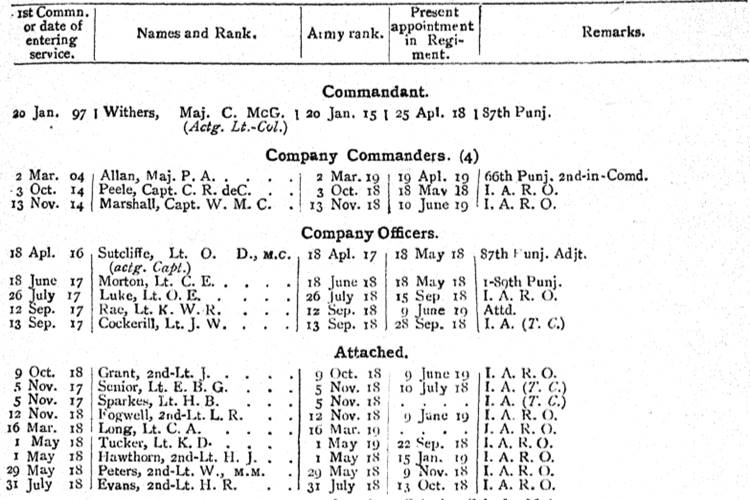This article is about the 1st Battalion 153rd Punjabis and will help you to research both the Battalion and those soldiers who served with it during the First World War. I have also written guides to the 2nd and 3rd Battalions:
The 1st Battalion 153rd Punjabis
Lineage: Formed in Mesopotamia in May 1918 and disbanded on 15 June 1921.
Class Composition of Battalion in 1919: 1 1/2 Companies of Punjabi Musalmans, 1/2 a Company of Jats, 3/4 Company of Sikhs, 3/4 Company of Rajputs and 1/2 a Company of Brahmans.
The 1st Battalion 153rd Punjabis was one of eighteen new Indian infantry battalions formed in the Middle East in 1918. These Battalions were created from drafts of other Indian infantry battalions to replace British battalions leaving the Middle East for Europe. This was in response to the German Spring Offensive and the heavy casualties sustained by the British Army. The 1st Battalion 153rd Punjabis was formed at Dialah, Mesopotamia (Iraq) from drafts from the following regiments:
- One Company 82nd Punjabis
- One Company 87th Punjabis
- One Company 89th Punjabis
- One Company 90th Punjabis
The Battalion did not remain in Mesopotamia for long as it moved to Egypt in July 1919. Once in Egypt, the Battalion joined the 159th Infantry Brigade, 53rd (Welsh) Division. The Battalion took part in the final stages of the Palestine Campaign including the Battle of Megiddo in September 1918. The 1st Battalion 153rd Punjabis returned to Egypt after the war before returning to India early in 1919. The Battalion served in the Third Anglo-Afghan War as part of Baluchistan Force and was disbanded on 15 June 1921.
The extract below was taken from the July 1919 Indian Army List and records the British officers serving with the 1st Battalion 153rd Punjabis. I’ve written a guide to help you decipher all the military jargon you find in these books: Indian Army Abbreviations and Acronyms.
War Diary of the 1st Battalion 153rd Punjabis
There is only one war diary for the 1st Battalion 153rd Punjabis which hasn’t been digitized and can only be viewed at the National Archives. I have transcribed some entries from the diary below.
- Date: 18 May 1918 – 31 January 1919
- 159th Infantry Brigade, 53rd (Welsh) Division, Egyptian Expeditionary Force
- Reference: WO 95/4630
- Notes: The only war diary for the 1st Battalion 153rd Punjabis is poor, with the majority of days having no entry. September 1918 is the only month which has long entries. British officers are mentioned throughout. There are a large number of appendices, typically orders.
Further Sources for the 1st Battalion 153rd Punjabis
If you are researching either a British or Indian officer who served with the Battalion, the Indian Army List can be consulted. Unfortunately, there was no regimental history published for the 153rd Punjabis nor are there any confidential reports.
Extracts from War Diaries
18 May 1918 – 31 January 1919, Egyptian Expeditionary Force, WO 95/4630
18 May 1918 – Dialah – One Company from 82nd Punjabis under Lieutenant A.G. Lester Garland… One Company from 90th Punjabis under Lieutenant C.R. Jessop… One Company from 87th Punjabis under Captain O.D. Sutcliffe… assembled at Dialah.
19 May 1918 – Dialah – One Company from 1st Battalion 89th Punjabis under Lieutenant J.S. Hannah and 2nd Lieutenant C.E. Morton…
07 June 1918 – Makina – Arrived Makina 7 am marched into standing camp.
08 June 1918 – Makina – Major C.M.G. Withers joined the Regiment and took over command.
20 June 1918 – Magil – Embark on H.T. Rembrandt. Sail at 9 am. 8 pm Arrive at Fao Bar and tranship to H.T. Hong Moh.
05 July 1918 – HT Hong Moh – 8 pm – Arrive Suez and disembark. 11 pm Entrain for Kantara.
11 July 1918 – Kantara – Equipped with 1914 pattern equipment.
23 August 1918 – Nejmeh – 1 deserter gave himself up.
24 August 1918 – Nejmeh – 2 reserve companies withdrawn and march to N19d, to take part in Divisional Forward Lewis Gun School.
04 September 1918 – Mary Cross – Commanding Officers were informed at Brigade conference that operations were impending and given a rough outline of the plan.
09 September 1918 – Mary Cross – Permission was received to tell as many British Officers as necessary about the forthcoming operations. All company commanders and adjutant were told in detail and quartermaster, transport officer and medical officer told to prepare for operations.
17 September 1918 – P31 C- Commanding Officer and Lieutenant Dowdeswell, did close reconnaissance from near out wire at mouth of Wadi Kola. Permission received to inform all Indian officers, accordingly. Commanding Officer explained plan and showed the ground from a point south of Kefr Malik.

